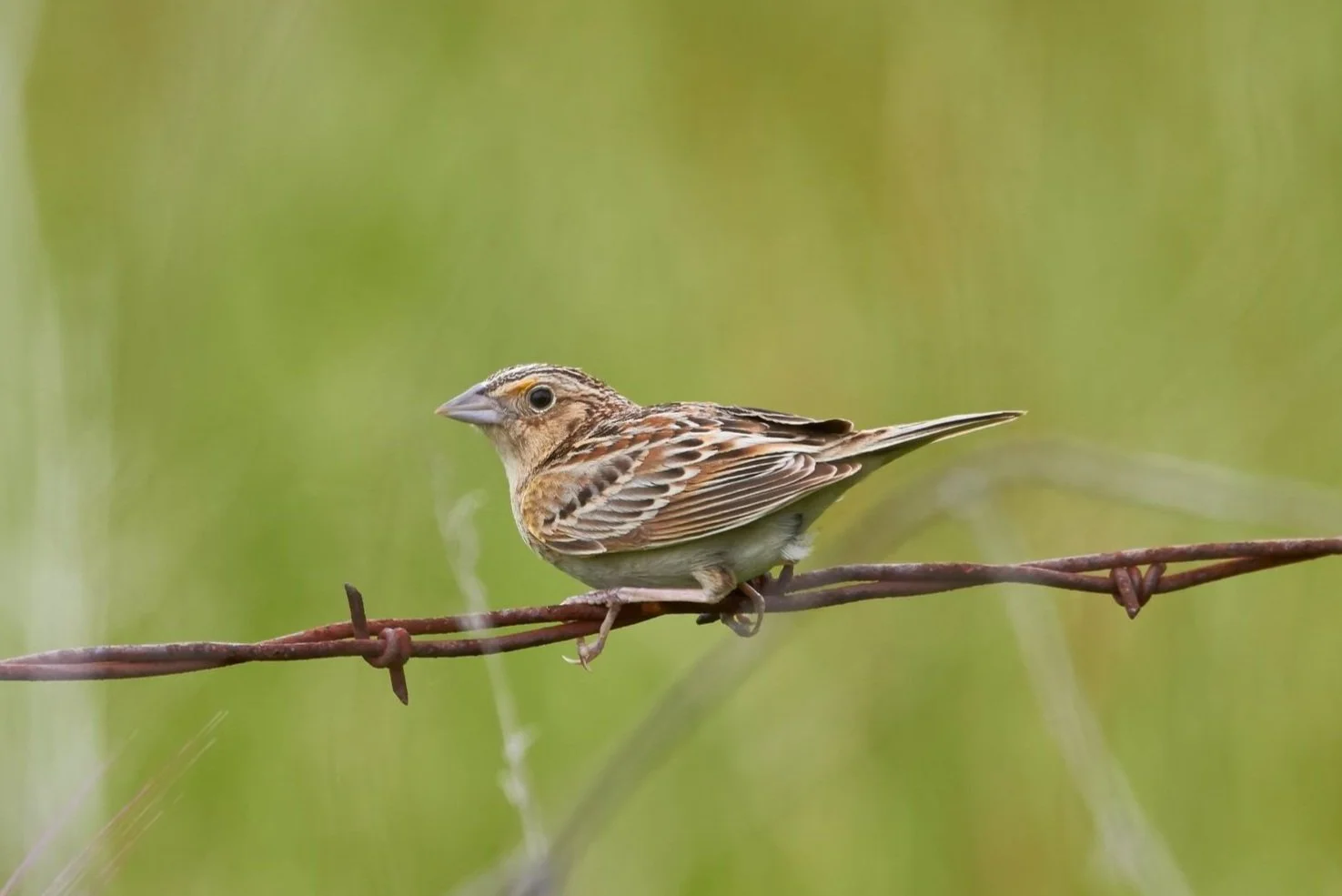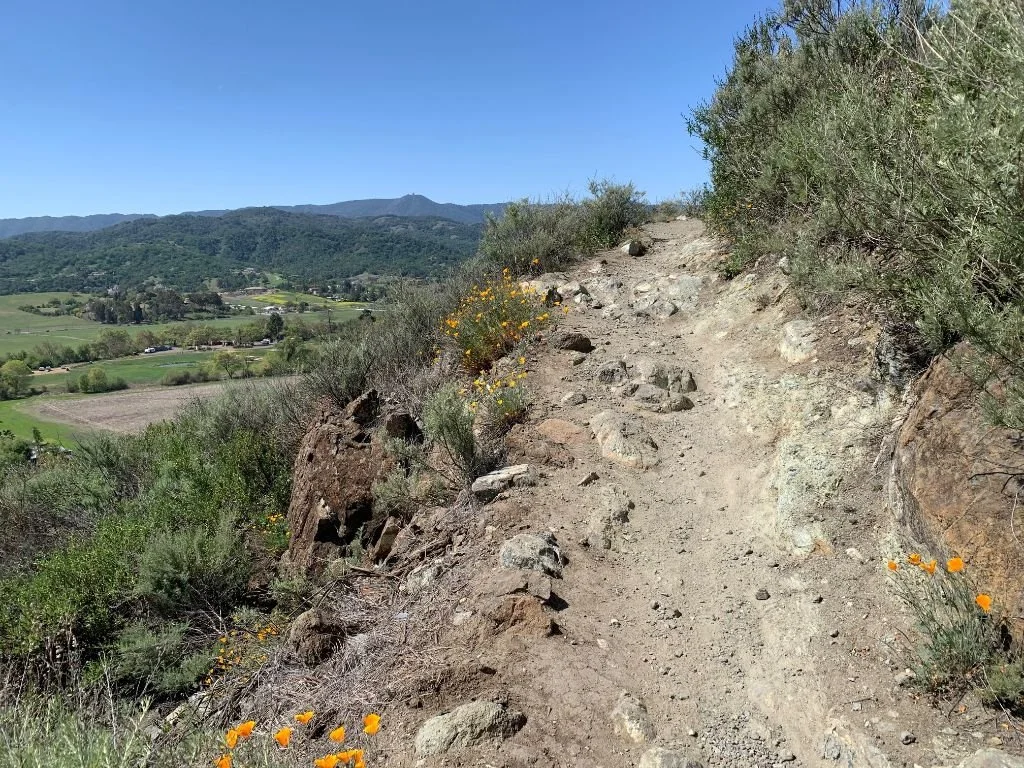Stile Ranch Trail in Santa Teresa County Park (Spring):
A Short Climb for Chaparral and Grassland Birds
By Brooke Miller
During spring along the Stile Ranch Trail, located in Almaden Valley, you’ll find species of birds that aren’t widely found in other areas of Santa Clara County such as Horned Lark and Grasshopper Sparrow, as well as a variety of wildflowers. As you ascend the trail up the south-facing hill you’ll get great views of the hills of Santa Teresa, Almaden Valley, and of Mount Umunhum and the Santa Cruz Mountains.
Trip Covers: March - May
Key Birds: Common Poorwill, Rufous and Allen’s Hummingbirds (there have been Calliope Hummingbirds here on occasion as well), Horned Lark, Wrentit, Blue-gray Gnatcatcher, Rock Wren, California Thrasher, Rufous-crowned Sparrow, Grasshopper Sparrow, Lark Sparrow
How to Bird
The Stile Ranch Trail is accessed from the southern side of Santa Teresa County Park, not the main park entrance. This guide covers 0.7 miles of the trail which runs alongside the IBM easement. This one-way steep climb passes through chaparral and grassland habitats for a good variety of birds. As you ascend the hill, you’ll have great views of Santa Teresa hills, Almaden Valley, Mount Umunhum and the Santa Cruz Mountains.
You’ll want to start your birding early in the morning when the birds are the most active, and the day hasn’t gotten too hot yet.
Chaparral habitat of the Stile Ranch Trail.
Birds in the Chaparral
From the parking lot on San Vicente Avenue, travel up the Stile Ranch Trail switchbacks that you see in front of you. You’ll be going up the hill through the chaparral (an ecological community composed of shrubby plants adapted to dry summers and moist winters). Along this section of the trail you’ll be looking for Allen’s and Rufous Hummingbirds, Wrentit, Blue-gray Gnatcatcher, California Thrasher and Rufous-crowned Sparrow.
Rocky Stile Ranch Trail with beautiful views. Photo by Eve Meier.
Allen’s and Rufous Hummingbirds are similar-looking hummingbirds and can be a challenge to identify since they both can occur in our area simultaneously. As a general rule, males with all orange backs and crowns are Rufous, while males with green backs and crowns, and orange tails are Allen’s. Females are tricky--the two species have different shaped inner tail feathers which can only be seen when their tails are splayed out and a photograph is taken.
Male Allen’s Hummingbird by Brooke Miller. Allen’s Hummingbirds are an early migrant (arriving in late January in Santa Clara County) and breed only in a narrow strip along the West Coast.
Male Rufous Hummingbird by Brooke Miller. Rufous Hummingbirds migrate through our area in late March to early April on their way to breed from Oregon to Alaska.
Check the tops of the bushes and trees for singing California Thrasher and Rufous-crowned Sparrow in the spring. California Thrashers are a relative of the mockingbird and have an exuberant song that both males and females sing from the tops of bushes. Rufous-crowned Sparrows spend most of their time walking or running on the ground; they are not strong fliers, and they don’t migrate. The chaparral at the Stile Ranch Trail is the perfect habitat to find them—dry, rocky hillsides with shrub cover.
Singing California Thrasher by Brooke Miller. They are year-round residents of dense chaparral habitat in Santa Clara County.
Rufous-crowned Sparrow by Brooke Miller. In the early mornings in spring the males sing short, jumbled songs (similar to House Wrens), from exposed perches.
Also look for skulky birds in the bushes. This includes Wrentits and Blue-gray Gnatcatchers. Wrentits are small birds with a big voice. You are much more likely to hear one singing (listen for a ping pong ball bouncing faster and faster) than to actually see one in a bush. Blue-gray Gnatcatchers are another small, skulky bird with a big voice. Their calls are thin, wheezy notes, while their song consists of wheezy notes of different pitches and lengths.
Wrentit by Brooke Miller. They are year-round residents of Santa Clara County in areas of coastal scrub and chaparral. Their diet consists of insects.
Blue-gray Gnatcatcher by Brooke Miller. They are here in Santa Clara County during the breeding season (spring – summer) in oaks and scrublands. Their diet consists of insects.
Birds in the Grasslands
At about 0.3 miles along the Stile Ranch Trail, the grade lessens and the trail continues through a gap in an old stone wall as you move into grassland habitat where Horned Lark, Rock Wren, Grasshopper Sparrow, and Lark Sparrow can be found among the grasses, a few bushes, and scattered rocks. This trail crests at 0.7 miles and this is your turnaround point (see interactive map).
Grasslands, rock wall and barbed wire fence along the Stile Ranch Trail. Photo by Eve Meier.
Along the grassland area of the Stile Ranch Trail scan with binoculars and listen for Horned Lark on the IBM easement side of the rock wall (to your left as you walk up the hill). These birds live in large, empty fields and are hard to spot. Look for movement, scan the low rocks, and also watch the air for birds flying, usually in groups. Horned Larks make a high-pitched, thin tinkling song.
Horned Lark by Brooke Miller. Horned Lark, about the same size as an American Robin, forage for seeds and insects, and have sharply declined in the last 50 years.
Lark Sparrows are here year-round in grasslands, pastures, and shrubby borders. Along the Stile Ranch Trail you may find Lark Sparrows just about anywhere above the chaparral. Lark Sparrows forage on the ground for seeds, but fly to bushes or small trees to perch.
Lark Sparrow by Brooke Miller. The male’s song is a jumble of churrs, buzzes, and trills. They sing from fence posts and wires. They forage on the ground for seeds, but fly to bushes and perch on top of them instead of running along the ground like many other sparrows.
Near and around the rock wall, look for Rock Wren. Rock Wrens hop around rocks looking for insects and spiders in the crevices. During spring, males sing from a prominent stone.
Rock Wren by Brooke Miller. They are found in dry, rocky environments that are sparsely vegetated with plenty of crevices and some shade. During nesting season (spring) males sing from a prominent stone. The Rock Wrens in Santa Clara County stay here year-round.
Like the Horned Larks, Grasshopper Sparrows are hard to find because they disappear into the grasses and run along the ground. You may find them by hearing their insect-like song which they sing from atop a stalk or bush. They may also perch on the barbed-wire fences. On the Stile Ranch Trail you may find them in the area past and above the gap in the stone wall.
Grasshopper Sparrow by Brooke Miller. Grasshopper Sparrows spend their breeding season in overgrown pastures and hay fields along the West Coast of California, and spend their non-breeding season in Mexico. Grasshoppers are their primary prey. This species is in steep decline due to habitat decline.
Ready for More?
The Stile Ranch Parking Lot is the perfect place to hear Common Poorwill in the early evening in the spring and summer.
There are several options in this area to continue your birding adventure. First, you can extend this trip by walking a full 2.5 mile loop using the Stile Ranch Trail and returning on the Fortini Trail (see park map). You can also explore the Calero Creek Trail which starts from the same parking lot. On the opposite side of McKean Rd, you can visit Calero County Park - Rancho San Vicente entrance, another great area for Rock Wren. Or, try the main entrance to Santa Teresa Park.
Interactive Map
Route Summary
From the parking lot pass the big trail sign and the shaded picnic table and you’ll reach a signed junction. Go left, onto Stile Ranch Trail. Walk up the path which has several switchbacks up the hill. At about 0.3 mile, the rocky trail drifts into grassland and the uphill grade lessens. Pass through a gap in an old stone wall and ascend along the boundary. The trail crests at 0.7 miles, and this is your turnaround point.
Stile Ranch Trail – Google Satellite, showing turn around point.
Directions: From CA-85 in San Jose, exit Almaden Expy south. Continue south for about 5 miles to the end of the road then turn right onto Harry Rd. Take the next left onto McKean Rd and go 1.3 miles. Turn left onto Fortini Rd and continue 0.6 miles. Turn left onto San Vicente Ave, the parking lot is on the right in less than 0.25 miles. Latitude/Longitude: 37.203355, -121.806013
Parking: Parking in a small gravel lot. No toilet facilities or water. No designated handicapped parking, the trail is not suitable for wheelchairs.
Parking Lot on San Vicente Avenue by Ron Horii
Fees: No entrance or parking fees.
Public Transportation: None
Park Hours: 8 am to sunset
Facilities: No restroom facilities at the trailhead parking lot or along the trail. Restrooms can be found at the Calero County Park-Rancho San Vicente Parking Area on McKean Rd. across from Fortini Rd. There is cell phone service at the parking lot and along the trail.
Trip Mileage: 1.5 miles round trip
Trail Conditions: Narrow dirt and rocky trail with several switchbacks. The trail faces South so it gets hot early. Watch out for bikes and loose rocks. Elevation gain is approximately 700 ft. in 0.7 miles
Accessibility: This trail IS NOT wheelchair accessible.
Bikes: Watch out for bikes both going up the trail and coming down the trail. They can be moving quite fast! Bikes are not recommended on this trip.
Dogs: Dogs are allowed on 6-ft leash
More Information
Santa Teresa County Park Website ***Note: there is no mention of Stile Ranch Entrance on this webpage.
eBird hotspot: Santa Teresa CP—Stile Entrance
All About Birds: Grasshopper Sparrow and Horned Lark
More Resources
For more trips like this one, visit Self-Guided Field Trips.
Visit the SCVAS Birding Resources page for more information on where to bird, our birding community, bird identification resources and more.
Read “What to Look for Now” by SCVAS Executive Director Matthew Dodder.
Banner Photo Credit: Grasshopper Sparrow by Brooke Miller
Last Updated: 4/14/2022
Enjoyed this Trip?
Support the work of Santa Clara Valley Audubon Society and become a member. To contact the trip writer with comments, questions or location updates, please email fieldtrips@scvas.org. You can also post in the comment section below. (If you’d like to post anonymously, type your comment, select “Post Comment”, then simply provide a name, like “Guest”, and select “Comment as Guest”.)
















